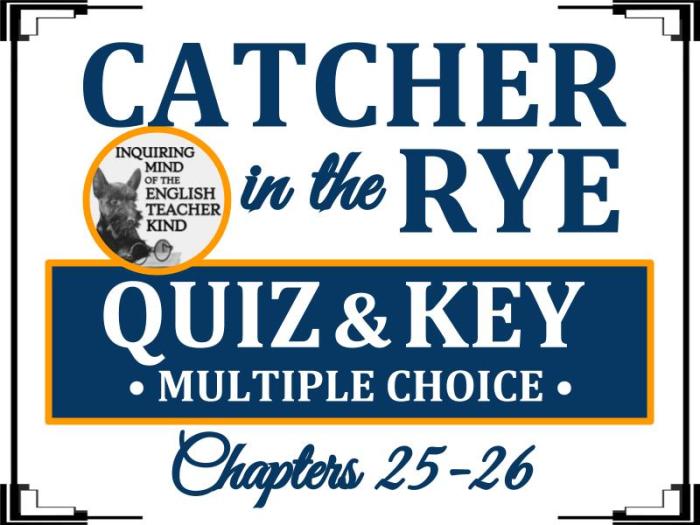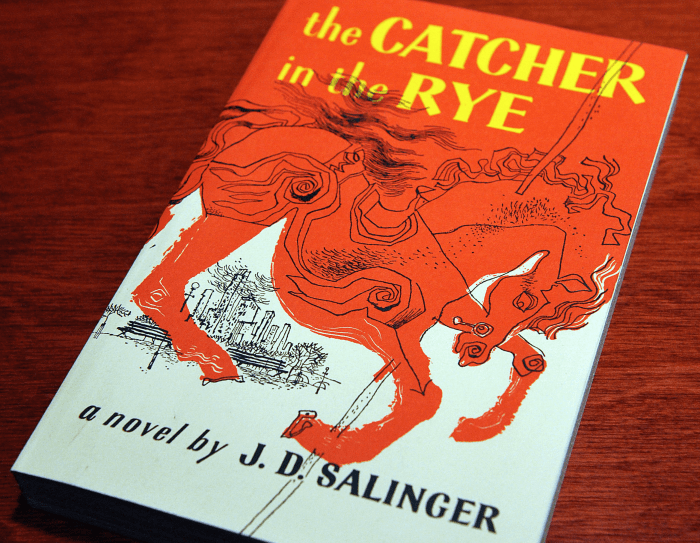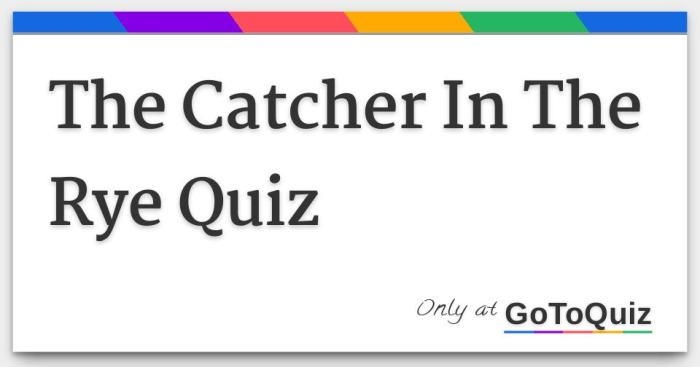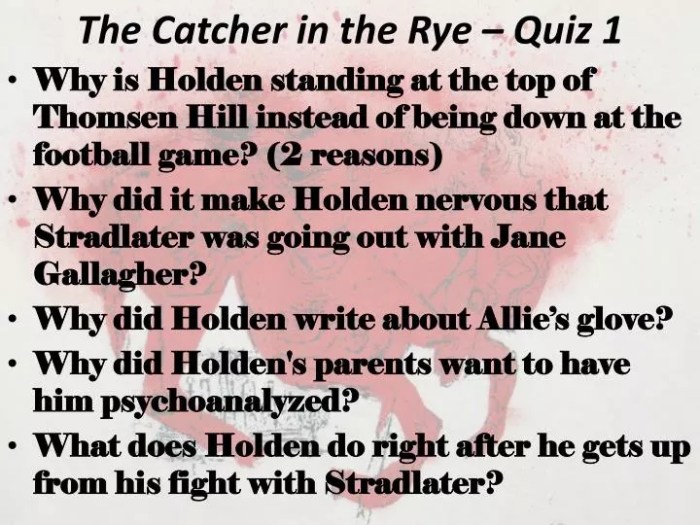Embark on a literary adventure with Catcher in the Rye Exam, where we delve into the enigmatic world of J.D. Salinger’s iconic novel. Prepare to explore the complexities of Holden Caulfield, navigate literary techniques, and unravel the cultural impact that has shaped generations of readers.
Holden Caulfield’s journey of self-discovery and alienation sets the stage for this captivating narrative, offering readers a glimpse into a story that is rich in detail and brimming with originality from the outset.
Character Analysis

Holden Caulfield is an iconic literary character who has resonated with readers for generations. As the protagonist of J.D. Salinger’s novel The Catcher in the Rye, Holden embodies the angst and alienation of adolescence, making him a timeless and relatable figure.
Themes of Alienation and Identity
Holden’s experiences in New York City highlight his feelings of alienation and isolation. He struggles to connect with others, finding them superficial and hypocritical. This alienation stems from his inability to conform to societal norms and expectations. Holden’s search for authenticity and meaning leads him to question his own identity and place in the world.
Relationships with Other Characters
Holden’s relationships with other characters in the novel shed light on his complex personality. His younger sister, Phoebe, represents his longing for innocence and purity. His former teacher, Mr. Antolini, provides guidance and support, but Holden’s mistrust and paranoia prevent him from fully embracing their connection.
Holden’s interactions with prostitutes and strangers highlight his search for genuine connections and his inability to find them.
The Catcher in the Rye exam is just around the corner, and I’m feeling a bit nervous. I’ve been studying hard, but I could always use some extra help. That’s why I’m checking out unit 7 session 1 letrs . It’s a great resource that provides practice questions and study tips.
I’m sure it will help me ace my exam. Back to the Catcher in the Rye exam, I’m confident that I’ll do well. I’ve put in the work, and I’m ready to show what I know.
Literary Techniques

The Catcher in the Ryeis renowned for its distinctive narrative style, extensive use of symbolism, and evocative setting.
Narrative Style
The novel is narrated by the protagonist, Holden Caulfield, in a colloquial and stream-of-consciousness style. Holden’s unfiltered thoughts and observations offer an intimate glimpse into the mind of an adolescent struggling with disillusionment and identity.
Symbolism and Motifs
- The Red Hunting Hat:Represents Holden’s desire to escape and protect himself from the adult world.
- Ducks in Central Park:Symbolizes the innocence and freedom Holden seeks.
- The Museum of Natural History:Represents the unchanging and stable world Holden yearns for.
- The Carousel:A symbol of the circularity and inevitability of life.
Setting
The novel is set in New York City during the 1950s. The bustling urban environment reflects Holden’s alienation and the societal pressures he faces. The city’s landmarks, such as the Museum of Natural History and Central Park, serve as both literal and symbolic backdrops for Holden’s journey.
Cultural Impact

The Catcher in the Rye has had a profound impact on American literature and culture. Its depiction of teenage rebellion and angst resonated with generations of readers and influenced the development of the young adult novel genre.
Portrayal of Teenage Rebellion and Angst
Holden Caulfield’s rebellious spirit and disillusionment with the adult world captured the feelings of many teenagers who felt misunderstood and alienated. The novel’s exploration of themes such as identity, authenticity, and the search for meaning spoke to the experiences of young people coming of age in a rapidly changing society.
Controversy and Censorship, Catcher in the rye exam
The Catcher in the Rye has been a subject of controversy since its publication. Its frank language, sexual themes, and depiction of teenage rebellion led to it being banned or challenged in schools and libraries. However, the novel’s enduring popularity and critical acclaim have led to its recognition as a classic of American literature.
Historical Context

The Catcher in the Rye was written in the post-World War II era, a time of significant social and cultural change. The war had left a profound impact on American society, leading to a widespread sense of disillusionment and alienation.
The novel reflects this postwar mood, as it explores the experiences of a young man, Holden Caulfield, who is struggling to come to terms with the complexities of the adult world. Holden’s alienation and cynicism are symptomatic of the larger social and cultural shifts that were taking place in the United States at the time.
Social and Cultural Factors
- The war had resulted in a significant loss of life and property, leaving many Americans feeling disillusioned and cynical.
- The rise of consumerism and materialism led to a sense of emptiness and alienation among many people.
- The Cold War created a climate of fear and uncertainty, as Americans worried about the threat of nuclear war.
Reflection of the Post-World War II Era
The Catcher in the Rye reflects the post-World War II era in several ways:
- Holden Caulfield’s alienation and cynicism are representative of the widespread sense of disillusionment that was prevalent in American society at the time.
- The novel’s exploration of themes such as innocence, loss, and identity reflects the social and cultural anxieties that were common in the postwar era.
- The novel’s use of slang and colloquial language captures the vernacular of the time, providing a vivid snapshot of American society in the late 1940s.
Question Bank: Catcher In The Rye Exam
What is the significance of Holden Caulfield as a literary character?
Holden Caulfield is a complex and relatable protagonist who embodies the struggles of adolescence, alienation, and the search for identity.
How does the novel explore the theme of alienation?
Holden’s alienation manifests through his detachment from society, his peers, and even his own family, highlighting the challenges of navigating a rapidly changing world.
What is the unique narrative style of “The Catcher in the Rye”?
The novel is narrated in Holden’s distinctive voice, characterized by its colloquial language, stream-of-consciousness, and introspective nature.
What is the controversy surrounding “The Catcher in the Rye”?
The novel has faced criticism for its use of profanity, sexual content, and portrayal of teenage rebellion, leading to debates about censorship and the role of literature in society.
